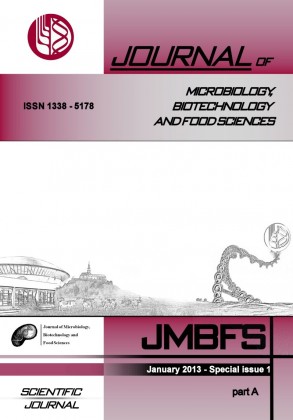CYTOTOXIC AND ANTIOXIDANT ACTIVITY OF BUCKWHEAT HULL EXTRACTS
Keywords:
antioxidant activity, buckwheat hull, cytotoxic effect, polyphenol contentAbstract
Buckwheat contains many prophylactic compounds that are concentrated mainly in outer layers of buckwheat grain. The aim of this study was to prepare buckwheat hull extracts. Ten buckwheat cultivars were screened for their antioxidant and anticancer properties. Total polyphenol content was determined using Folin-Ciocalteau's reagent. Antioxidant activity was established by the method of binding free radical DPPH. Cytotoxic properties were measured on human cervical cancer cells HeLa using mitochondrial cytotoxic test (MTT). Total polyphenol content ranged from 166.67 to 635.31 mg GAE/100 g DW. The highest content displayed tartary buckwheat cultivar Madawaska (0.64% of hulls weight). Among common buckwheat the richest in polyphenols were cultivars Bamby and KASHO-2. The best free radical binding antioxidant activity was found for cultivars with highest polyphenol content. This relationship was not observed for cytotoxic action on human cervical cancer cells. The best growth inhibitory activity on HeLa cancer cells displayed common buckwheat cultivars Bamby and KASHO-2 (up to 50%, extract concentration 100 µg/ml). This was not found for tartary buckwheat cultivar Madawaska.Downloads
Download data is not yet available.
Downloads
Published
2013-02-01
How to Cite
Danihelová, M., Jantová, S., & Å turdÃk, E. (2013). CYTOTOXIC AND ANTIOXIDANT ACTIVITY OF BUCKWHEAT HULL EXTRACTS. Journal of Microbiology, Biotechnology and Food Sciences, 2(special issue 2), 1314–1323. Retrieved from https://office2.jmbfs.org/index.php/JMBFS/article/view/7453
Issue
Section
Biotechnology
License
Copyright (c) 2013 Martina Danihelová, Soňa Jantová, Ernest Å turdÃk

This work is licensed under a Creative Commons Attribution 4.0 International License.
All papers published in the Journal of Microbiology, Biotechnology and Food Sciences are published under a CC-BY licence (CC-BY 4.0). Published materials can be shared (copy and redistribute the material in any medium or format) and adapted (remix, transform, and build upon the material for any purpose, even commercially) with specifying the author(s).

